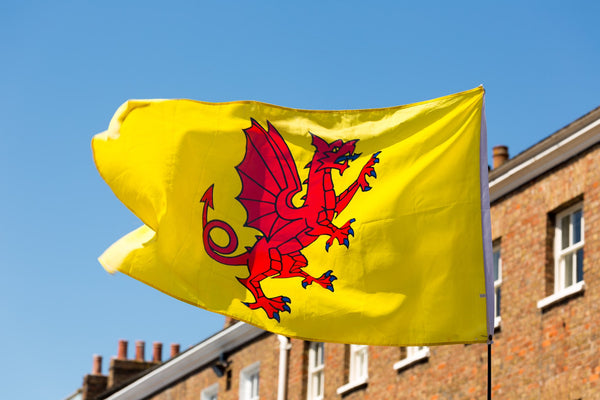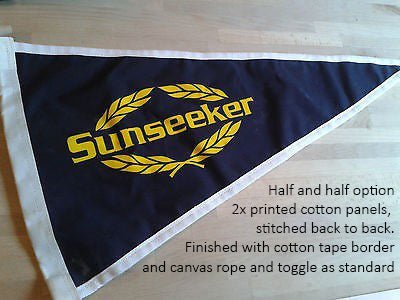Fire retardant treatment and regulations for flags and banners
Stadiums and large venues must use flags and banners that meet the fire-retardancy standards outlined in UK BS 5867 Part 2 Type B and BS5852 Part 2, France M1 and Germany B1 regulations.
Send your flag to us and we will treat your flag, stitch in a certification label to show it has been treated correctly and send it back to you. The process takes about 48 hours - time to allow the spray treatment to dry completely before packing and shipping your flag back to you.
We will advise on which address to send your flag to on receipt of your order. Please include a paper copy of your order when sending the flag to us for ease of reference at our end.
Please note that the stitched-in label is enough to take your flag anywhere - no paper certification is required but we can email you an order-specific Flag Studio purchase and treatment certificate on request if required and at no extra charge - this will be emailed to you in digital format.

Please allow enough time for this service to be completed correctly ahead of any stadium / match visits you're planning!
Product information*
*source: Flametect
-
Tested in the UK, EU, French M1, German DIN 4102, USA-NFP701
-
UK Developed and Manufactured Exclusively by Eco-Sol Ltd in conjunction with a Queens Award For Enterprise Chemical Manufacturer.
-
Kinder to you and the material being treated. Neutral PH and does not contain corrosive ammonium polyphosphate.
-
Certificate provided with each order for the relevant British Standards.
-
Non Corrosive to Metals. Unlike other flame retardants it will not corrode metals
-
Used extensively in SFX, Theatre, TV and Film Costume and Set (Inc Disney On ice, BBC Casualty Dr Who, Game of Thrones, Vikings, Harry Potter etc)
-
Safer than any other flame retardant on the market. Safe to use around younger and older generations.
-
Supplied to: Fire Service, National Trust, Hotels, Schools, Care Homes, Social Housing and Student Lets.
-
Effective on natural and synthetic materials including decorations and artificial plants and trees.
-
Dry Cleanable up to 10 Cycles. Re-Treatment is required If wet washed
-
Dermally Tested. (Non Irritant). See Report
Nitro is the only flame retardant product available that has been tested independently by the "Institute for Skin and Product Evaluation" for dermal reaction with a full pass result.
Multi-Purpose: use on synthetic or natural materials, preferred for apparel, carpeting, and any item that may have a metallic element or embellishment, such as curtains with gold or silver yarns or metal furniture that could be tarnished by some corrosive flame retardants.
Our products are designed to be easily applied using basic DIY skills or we can help source professional contract spraying teams for the larger projects.
Iron-on labels: Public Areas such as Hotels, Public Houses, Nursing Homes, B&B's and Schools : It is a legal requirement for Curtains treated with Flame retardant to be labelled with care and durability instructions.
-
High active solids: 30% compared to around 15% of our competitors products. Which means it goes further and you do not need to saturate the material.
-
Quicker drying times. (Ready to use in 2-3 hours). Easy to apply
-
Non-toxic, non-hazardous formulation and completely Odourless.
-
Halogen and Bromine Free! "
-
Non Hygroscopic and Non-Corrosive. View Test Report.

BS5438 Bottom edge Ignition. BTTG 2023 Pass
Used extensively in Schools, Colleges, Nursing Homes, Public Houses and Hotels.
Treats: Polyester, Cotton, Silk, Linen flax, Wool, Cardboard, polystyrene, lycra, hessian, foam rubber and most other materials that can absorb.
-
Certification with every order traceable to A UKAS accredited laboratory
-
Produced in an ISO 9001 Quality Assured environment to exacting standards
-
Treats on average 7-10 sq. metres per litre. Possibly more on light weight materials.
-
Water based flame retardant. No nasty solvents.
-
Suitable for apparel and bedding
-
Non-sting formula. Safe on skin.
-
Statement of performance with every order. See Example
-
Excellent performance on artificial flowers
-
Suitable for spray, roller or immersion application.
-
Dry clean durable (upto 10 Cycles)
-
Performs To M.C.A. and I.M.O standards for charter vessels and passenger ships (See NX2)
-
Effective on natural, natural/synthetic blends and most synthetic textiles.
-
Order by 3:00pm for next day delivery.
-
Contract Spraying Service click for details.
Typical applications
-
Apply to Natural and Artificial Christmas Trees, Decorations and costume.
-
Curtains and drapes, including theatre stage and wing curtains (inc. Synthetic Materials)
-
Stage props, flat sets and scenery
-
Theatrical costumes and party clothing
-
Boat beds, bunks and curtains
-
Aircraft seating and carpets
-
Artwork, Paper and Card
-
Artificial Grass (Astroturf) See test report
-
Papier mache projects and collages
-
Lighting special effects for theatre & stores
-
Tapestries and wall hangings
-
Banners and signs for internal use
-
Rugs and Carpets (Including Synthetic Carpets)
-
Temporary fireproof barriers
-
Retail Displays
-
Wall Paper and Coverings (Test Report)
-
Hay and straw internal scenery for seating
-
Foams and Sponges
BS5867 P2 type B Damask Fabric Test Report
BS5867 P2 type B Linen Fabric Test Report
BS5867 P2 type B Polyester Lycra test Report
Comparison between M1 (France) and B1 (Germany) product tests in the EU
Fire Ratings Explained
Passive fire protection, testing and standards
 In order to comply with building regulations, measures to subdue the spread of fire to other parts of a building must be taken. In terms of components and coatings for the walls and ceilings, there are two key measures of fire testing.
In order to comply with building regulations, measures to subdue the spread of fire to other parts of a building must be taken. In terms of components and coatings for the walls and ceilings, there are two key measures of fire testing.
These measures are concerned with Reaction to Fire - Retardancy (the measurement of the ability of a material to resist or prevent the passage of fire from one area to another and Reaction to Fire – structural Integrity, the measurement of how a material will contribute to the fire being able to develop.
1. REACTION TO FIRE (RETARDANCY) - FIRE AND SMOKE RETARDANCY COATINGS
When deciding on the correct coating system to provide Fire protection to a combustible material such as timber, it is essential that the products meet the standards set out by the new Euroclass System for the fire safety classification of building materials.
The test methods are totally new and involve exposing the product to direct flame and is called the Single Burn Test or SBI Test.
This test is designed to simulate the flame exposure that would be experienced by material lining the walls of a room when a "wastepaper basket" ignites next to the wall in the corner of a room.
The test measures a Fire Growth Rate (FIGRA), the heat energy contribution to the fire from the product. The result is categorised on a Fire Growth Rate Index.
A second measurement is taken to calculate the volume of smoke produced by the fire and categorised according to a Smoke Growth Rate (SMOGRA) index.
Finally, the test also measures oxygen consumption as well as carbon dioxide and carbon monoxide production. These gas concentrations help identify the heat release and the burning characteristics of the tested products.
The Standards to the Euroclass system are referred to as;
- European standard - EN 13501-1 reaction to fire classification with parts
- BS EN 13823: 2010+A1:2014 single burn test (SBI) and
- BS EN11925-2:2010 single flame ignitability test (SFI).
Classification of individual products
To provide guidance to the user/specifier regarding the performance of a particular product under test. Information is provided by the following process:
There are seven Reaction to Fire classes.
|
A1 |
The Product is classed as a Non-Combustible |
|
A2 |
Limited Combustibility |
|
B |
Combustible materials – Very Limited contribution to fire |
|
C |
Combustible materials – Limited contribution to fire |
|
D |
Combustible materials – Medium contribution to fire |
|
E |
Combustible materials – High contribution to fire |
|
F |
Combustible materials – Easily flammable |
These classes are further divided to provide information on a product’s tendency to produce smoke and flaming droplets / particles based on the results of the SBI Test.
Smoke Generation
Smoke generation is measured for Reaction to Fire classes A2 to D. Smoke emission classifications are not provided for products with an E or F overall rating.
There are three smoke intensity levels:
|
s1 |
Emissions absent or very little |
|
s2 |
Emissions with average volume intensity |
|
s3 |
Emissions with high volume intensity |
Fire Generation
Burning droplets/particles can inflict skin burns and cause further spread of fire. Burning droplets/particles are measured for Reaction to Fire classes A2 to E. E-rated products receive a d2 flaming droplet classification. F-rated products receive none.
There are three classes of burning droplets:
|
d0 |
No burning droplets |
|
d1 |
Slow dripping droplets |
|
d2 |
High/Intense dripping droplets |
For example:
B/S1/d0
translates to:
-
B - Combustible materials – Very Limited contribution to fire
-
s1 - Smoke emissions absent or very little
-
d0 - No burning droplets
Classification according to European Standard EN-13501-1
|
DEFINITION |
CONSTRUCTION PRODUCTS |
||
|---|---|---|---|
|
Non-combustible materials: No contribution to fire |
A1 |
||
|
Limited combustibility |
A2 - s1 d0 A2 - s2 d0 A2 - s3 d0 |
A2 - s1 d1 A2 - s2 d1 A2 - s3 d1 |
A2 - s1 d2 A2 - s2 d2 A2 - s3 d2 |
|
Combustible materials: Limited contribution to fire |
B - s1 d0 B - s2 d0 B - s3 d0 |
B - s1 d1 B - s2 d1 B - s3 d1 |
B - s1 d2 B - s2 d2 B - s3 d2 |
|
Combustible materials: Minor contribution to fire |
C - s1 d0 C - s2 d0 C - s3 d0 |
C - s1 d1 C - s2 d1 C - s3 d1 |
C - s1 d2 C - s2 d2 C - s2 d2 |
|
Combustible materials: Medium contribution to fire |
D - s1 d0 D - s2 d0 D - s3 d0 |
D - s1 d1 D - s2 d1 D - s3 d1 |
D - s1 d2 D - s2 d2 D - s3 d2 |
|
Combustible materials: High contribution to fire |
E |
E - d2 |
|
|
Combustible materials: Easily flammable |
F |
||









